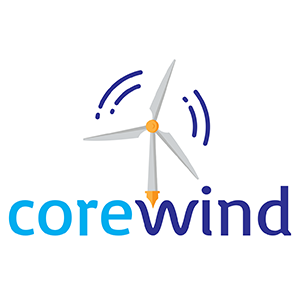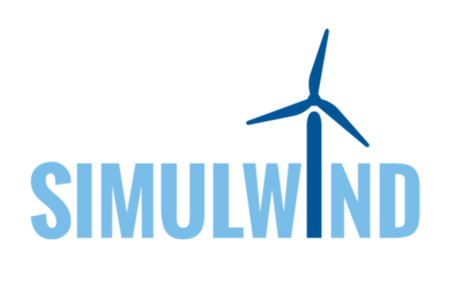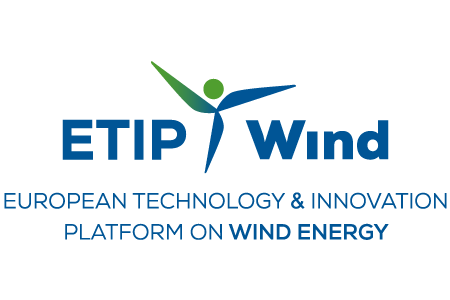|
Upcoming EU funding opportunities and Research & Innovation policy
The European Commission has announced the details of 2021-2022 Horizon Europe work programme priorities. Wind energy will benefit from at least €154m, which is double what we had in the previous years. Aside from that, there is an extra €207m of funding available, as part of additional calls for proposals in the renewable energy technologies area. More information on the calls can be found on the European Commission’s funding and tenders portal. Click here to learn more about the wind specific calls and register for our webinar to see how your organisation could benefit from these funding opportunities. Webinar: “R&I funding under Horizon Europe: what’s in it for wind” 4 October, 10:00-12:00 CEST (Register here) Carlos-Eduardo Lima de Cunha, Policy Officer from the European Commission, will give you a full overview of the open calls for wind energy and renewables. Francesca Harris, Project Manager at CINEA (the Executive agency in charge of evaluating applications), will help you navigate the rules and share tips and tricks on how to successfully apply for the calls. During the second part of the webinar you will get a chance to connect with other companies and research organisations to find a partner for your next EU-funded project! For more information, contact Sabina Potestio.
22 Member States submitted their draft Recovery & Resilience Plans (RRPs) to the European Commission. The RRF represents an unprecedented EU-level fiscal intervention (€673bn) to revive the European economy in the wake of the COVID-19 pandemic. And its objective is to make it greener, more digital, and more competitive. Making the most of EU’s recovery and resilience facility Wind energy projects are well placed to benefit from these funding opportunities. If you have a project that needs public funding, contact Sabina Potestio to check its eligibility or look at the technical guidance and other supporting documents here. For rolling updates on the instruments and budget, please visit our WindEurope website.
The Connecting Europe Facility (CEF) programme funds the development of high-performing and sustainable infrastructure in the fields of energy, transport and digitalisation across Member State borders.
The European Commission is in the final selection stage for large – scale projects submitted in 2020, who have applied to receive funding from the Innovation Fund (€1,100m). The next call for large-scale projects will open on 26 October with the application deadline in March 2023. The European Commission is planning to allocate between €1,300m and €1,500m of funding and the submission requirements should be similar to those of the 2020 large-scale projects’ call. The results will be ready to announce by summer 2023, with grants being allocated by November 2023. The European Commission will also provide €100m funding to 30 small-scale projects (less than €7.5m), under the 2021 call. The results are expected to be announced this summer and grants will be signed by October 2021. The next call for small-scale projects will open in March 2022, with a budget of €100m, and the application deadline in August 2022. Grants will be awarded in Q2 of 2023. For more information, contact Alexander Vandenberghe.
Eager to know what funding opportunities your hydrogen project could benefit from? The European Commission has just launched the Hydrogen Public Funding Compass, a platform which helps stakeholders find all the relevant information they need to access public funding. It has an overview of funding opportunities both at EU and Member State level. This platform is a tool of European Clean Hydrogen Alliance, that is developing an investment pipeline of clean hydrogen projects. In June, the European Commission announced that 996 projects were already submitted to deliver the European Hydrogen Roadmap. It also provides background information on Important Projects of Common European Interest (IPEIs) on hydrogen. For more information, contact Sabina Potestio. News from WindEurope Projects
The Corewind project partners have developed the FowApp, a flexible and intuitive application for early project planning of floating offshore wind farms. The application calculates the energy produced, life-cycle costs, environmental impacts and Levelised Cost of Energy (LCOE) of floating offshore wind farms. The application was tested earlier in March this year and its commercial deployment is expected by the end of this year. Read more about the application here. For more information, contact Sabina Potestio. About Corewind: The COREWIND project provides disruptive and cost-effective solutions for floating offshore wind technology leading to cost reduction. It is developing innovative research, modelling and optimisation for concrete-based floating substructure concepts. Follow us on our social media accounts, Twitter and LinkedIn.
We launched new report ‘Getting Fit for 55 and set for 2050: Electrifying Europe with wind energy’. It was presented at an online event in June. You can watch all the sessions here or just take a look at the key messages:
Watch the new ETIPWind video: ‘ETIPWind, helping European R&I power our future’! It highlights the central role of research & innovation (R&I) in the success of Europe’s wind industry. And the importance of continuing investments in R&I. For more information, contact Raquel Alemañ. About ETIPWind: ETIPWind works to define and agree on concrete research and innovation (R&I) priorities and communicate these to the European institutions and other decision-making bodies in order to support the EU’s ambition of a decarbonised economy by 2050.
The RES Simplify partners have now finished mapping permitting procedures for new renewable energy installations across all the EU Member States, Norway and Iceland. The findings were verified with the wind and solar industry. They include:
The project partners are working closely with the European Commission, feeding in the relevant findings along with suggestions to allow for more efficient permitting in Member States. For more information, contact Sabina Potestio. About RES Simplify: The RES Simplify project is a project funded by the European Commission, addressing permitting of renewable energy. It is coordinated by the Consultancy Eclareon, partnering with Oeko-Institut, WindEurope and SolarPower Europe. The project aims to speed up the permitting process at a national level for new renewable energy projects, including onshore and offshore wind.
On 5 and 6 July the European Climate, Infrastructure and Environment Executive Agency held the first series of Horizon Europe info days focusing on Cluster 5 ‘Climate, Energy and Mobility’. It presented the new Horizon Europe research and innovation call for proposals including scope, timeline and application rules. These projects should all contribute to accelerating the green and digital transitions needed to achieve climate neutrality in Europe by 2050.  Are you part of a European or national research project and you want to promote it? Would you like to attract new partners and disseminate your results? Take a look at WindEurope’s Innovation Park! It is a pavillion designed to promote projects’ research and findings, and will be part of Electric City 2021 in Copenhagen (23-25 November 2021). The goal of the pavillion is to provide high-profile visibility to projects on the exhibition floor, giving partners access to greater publicity and networking opportunities. Benefits include:
For more information, contact Tanguy Grandjean.
|
||
WindEurope’s Quarterly Newsletter on Funding opportunities and European projects March 2021
|
WindEurope’s Quarterly Newsletter on Funding opportunities and European projects
Your gateway to WindEurope’s EU-funded projects, European Funding Opportunities and the latest on funding Policies.
News from WindEurope projects
The Corewind team has been working on a report on floating-wind-specific O&M requirements and monitoring technologies which is available to download on the Corewind website. The document identifies state-of-the-art techniques in order to enable economic O&M operations for future commercial floating wind farms.
The adhesion of proteins or microorganisms on wetted surfaces can influence the behaviour of the components submerged in the sea. Therefore, the COREWIND project has been analysing marine growth and biofouling in all system components (turbines, floating structures, mooring and dynamic cables). The project partners sent material samples for anchors and dynamic cables to the Marine Corrosion Test Site “El Bocal” located on the Cantabrian coast near Santander. The results will help validate the model assumptions for different components of the floating system.
Follow us on our social media accounts, Twitter and LinkedIn.
For more information, contact Sabina Potestio.
About Corewind: The COREWIND project provides disruptive and cost-effective solutions for floating offshore wind technology leading to cost reduction. It is developing innovative research, modelling and optimization for concrete-based floating substructure concepts.
Health and Safety (H&S) is a top priority for the wind industry. But how is it addressed in each country? Why does the industry need to follow different approaches and regulation to achieve the same goal? The project WindHarmony, funded by the European Commission, has been looking into these questions and has assessed the potential for harmonisation of H&S regulations and standards across Europe. The final results are available here. A series of best practice events were organised in September and October across Europe. Did you miss them? Don’t worry, you can access them here.
If you don’t have time to watch but would like a quick summary, read our latest post here.
After two years of intense industry discussions the project is now finished. There are 7 priority areas for potential harmonisation of H&S standards. And the consortium has developed a database on national H&S regulation that has been made publicly available.
For more information contact Sabina Potestio.
About WindHarmony: The Wind Harmony project looks at health and safety (H&S) regulations and related standards impacting onshore and offshore wind energy across in Europe. It assesses and prioritises their potential for harmonisation or other type of intervention at European level.
With accelerated policies, floating offshore wind could reach cost parity with bottom-fix offshore in the next decade, very much depending on the speed of deployment and research policies.
ETIPWind produced a graphic overview of the state-of-the-art floating offshore wind technology and the measures needed for commercialisation. The report spells out the sector's R&I recommendations allowing Europe to take the lead in a vast and untapped global market, as well as supporting European competitiveness. The topic was addressed in a webinar earlier this year. Did you miss it? See the video here.

For more information, contact Alexander Vandenberghe.
About ETIPWind: ETIPWind works to define and agree on concrete research and innovation (R&I) priorities and communicate these to the European institutions and other decision-making bodies in order to support the EU’s ambition of a decarbonised economy by 2050.

Permitting is today’s main bottleneck for new wind farms. It often takes 3 years or more for authorities to decide on a permit. These delays add to the costs of developing a wind farm, deter investors and stifle technological innovation.
WindEurope has joined forces with other renewable energy sectors and partners to tackle permitting issues in a 3-year project funded by the European Commission: the RES SIMPLIFY.
As a first step, the partners are mapping the permitting procedures in different countries. Secondly, we will monitor and evaluate the performance of these permitting procedures based on key performance indicators. The results of the monitoring and evaluation, in combination with other sources of good practice will then be used to identify transferable good practice approaches that should be reflected in the next revision of the Renewable Energy Directive and that can be applied in Member States.
WindEurope organised a workshop on 20 October with wind farm developers and national associations to identify the appropriate performance indicators to assess the efficiency and effectiveness of permitting processes in Member States. The participants validated the indicators proposed by the project partners. Some examples include cost of administrative/grid connection procedures, process duration, the average response time of authorities/TSOs/DSOs, the average number of staff in authorities to assess permits and the minimum distance to housing.
For more information, contact Sabina Potestio.
About RES Simplify: The RES SIMPLIFY project is a project funded by the European Commission on permitting of renewable energy. It is coordinated by the Consultancy Eclareon, partnering with Oeko-Institut, WindEurope and SolarPower Europe. The project aims to speed up the permitting process at a national level for new renewable energy projects, including onshore and offshore wind.
European Funding Opportunities & Policies

1. Recovery & Resilience Facility
The European Parliament’s position on the Recovery & Resilience Facility (RRF) was voted on in committee on 10 November. Negotiations between the European Parliament, European Commission and EU Council on the final form of the €672.5bn funding instrument are expected to be concluded by the year’s end. All three institutions agree that 37% of RRF funding should go to climate-related spending.
Five Member States have already published high-level Recovery & Resilience Plans (RRPs): Spain, Romania, Portugal, Czechia, and Slovenia (see graph below). The Romanian plan is the most ambitious as it represents up to 16% of gross national income while the Spanish plan represents the largest absolute amount, with €140bn planned.

The European Commission is currently engaged in discussions with these Member States on the details of their plans, to ensure they meet both the criteria in the draft RRF regulation, and the Commission guidance published in September. Final drafts of the RRPs should be ready by 30 April 2021 for evaluation by the European Commission.
2. InvestEU
Trilateral negotiations are also underway on InvestEU, the European Commission guarantee to de-risk loans from the European Investment Bank and other public financial institutions. The institutions are currently far apart. The European Parliament supports a budget of over €40bn, with guarantees provisioned at 45%, while the Council of the European Union supports a budget of just €9.4bn, with guarantees provisioned at 40%. The Council’s position makes no mention of the Strategic Investment Facility first proposed by the European Commission in May.
3. Just Transition Fund
On Wednesday Green MEPs managed to get rid of natural gas funding from the €17.5 billion Just Transition Fund (JTF) in the final round of trilogue negotiations. The European Commission and Council positions already excluded gas funding, but Parliament had approved an opinion in September allowing for fossil spending in regions expected to have a tough time switching from coal to renewables.
For rolling updates on the instruments and budget, please visit our WindEurope website.
If you have a project that wants to benefit from funding, contact Sabina Potestio.
On 11 November, EU members states approved the European Investment Bank (EIB) Group Climate Bank Roadmap 2021-2025.
The Roadmap describes how the EIB will support the objectives of the European Green Deal and sustainable development outside the European Union. This includes:
- Allocating €1 trillion in investment for climate action and environmental sustainability in the decade to 2030;
- EIB Group aligning all financing activities from the end of 2020 with the goals of the Paris Agreement;
- More than 50% of annual financing dedicated to green investment by 2025;
- More green advisory services and financing of innovative low carbon technologies;
- Support for green capital markets, climate change adaptation, Just Transition projects.
EIB President Werner Hoyer stated that the roadmap constitutes a significant contribution to the role of Europe which is leading the effort for decarbonisation and the building of a green, resilient economy leaving no one behind.
For more information, contact Guy Brindley.
The European Commission has opened a call for Research & Innovation projects, with a €1 billion budget under Horizon 2020, to help the EU deliver on the Green Deal in the form of grants. Funding is also available for wind energy. The call is open until 26 January 2021 and is subdivided into different topics:
- Innovative land-based and offshore renewable energy technologies and their integration into the energy system;
- Developing and demonstrating a 100 MW electrolyser upscaling the link between renewable and commercial/industrial applications;
- Closing the industrial carbon cycle to combat climate change – industrial feasibility of catalytic routes for sustainable alternatives to fossil resources;
- Green airports and ports as multimodal hubs for sustainable and smart mobility.
More details about the call are available here.
In October, WindEurope organised a Sofa Talk with the European Commission’s experts, who gave us all necessarily tips and steering in helping proposals to succeed. A very insightful session. Our top recommendation for those involved in the current call. Did you miss it? Don’t worry, you can access the video here.
For more information, contact Sabina Potestio.

The Blue Economy Window is a “window” of opportunities in the form of grants, allocated to SME projects every year through the European Maritime and Fisheries Fund (EMFF).
This time around, it’s €20M for projects from SMEs contributing to the Green Deal goals. SMEs are considered the backbone of our economy and will play a huge role in the post-COVID recovery.
Relevant areas for the blue economy include renewable energy, cleaner shipping, digital transformation of ocean and coastal activities and enabling technologies such as sensors, corrosion or biofouling resistant materials, coating, digitisation, electricity transmission equipment or multi-purpose platforms.
The call is open until 16 February and aims at:
- Bringing to market new products, services, processes, and business models in blue economy value chains and helping to advance their market-readiness;
- Developing a sustainable and innovative blue economy in Europe's sea basins;
- De-risking investment in these projects to facilitate their access to other financing schemes for the next stages of their activities.
Who can apply?
Minimum of 1 for-profit SME from any EU Member State + the UK.
How much support can companies expect?
70% co-funding. Indicative requested contribution between €700,000 & €2,500,000
What is the EC looking for?
- Close-to-market activities (TRL 6-8);
- Innovation & impact-oriented investment;
- Strong management teams;
- Support from investors or customers.
Can these funds be combined with other EU funds?
No. Beneficiaries cannot simultaneously receive finance from other public sources.
For more information, contact Sabina Potestio.

One of the world’s largest funding programmes for the demonstration of innovative low-carbon technologies, the Innovation Fund has recently allocated €1bn to 311 projects including 58 on renewable energy (look out for the upcoming ETIPWind newsletter in January on R&I to get more information on wind projects!). This first call for projects was also 22 times oversubscribed! (projects worth €21.7 bn for only €1bn available). The fund has now opened a call for small-scale projects with less than €7.5m in CAPEX and has a budget of €100m to allocate.
The call will support innovative, state-of-the-art projects that go beyond incremental innovation and that support the Green Deal objectives. The deadline to apply is 10 March 2021.
What are the award criteria?
- Degree of innovation. If a proposal scores less than the minimum threshold under this criterion, the evaluation is stopped (the remaining criteria are neither evaluated nor scored);
- Project maturity and greenhouse gas emissions avoidance potential. If a proposal scores less than 50% of total points under the project maturity criterion, if it does not meet the minimum requirements or is found to have a manifest error under the greenhouse gas emission avoidance potential criterion, the evaluation is stopped (the remaining criteria are neither evaluated nor scored);
- Scalability and cost efficiency.
The funds can be used in cooperation with other public funding initiatives, such as State aid or other EU funding programmes.
Applicants will be informed about the results of the evaluation in the fourth quarter of 2021. Full info on the call can be found here. And you can listen to the info webinar here.
For more information, contact Sabina Potestio.
The European Commission has approved an investment package of more than €280 million from the EU budget for new LIFE programme projects. Among other challenges, these projects will support the EU Biodiversity Strategy to 2030, contribute to the EU’s Green recovery post-COVID-19, and help Europe become a climate-neutral continent by 2050.
The LIFE programme will become more and more important for wind as of 2021. A specific sub-programme on energy will be added to the budget line. So keep an eye on its upcoming funding opportunities next year!
For more information, contact Sabina Potestio.
Are you part of a European or national research project and you want to promote it? Would you like to attract new partners and disseminate your results? Look no further – we have the perfect solution for you. WindEurope’s Innovation Park is a pavilion designed to promote projects’ research and findings, and will feature at Electric City 2021 in Copenhagen (27-29 April). The goal of the pavilion is to provide high-profile visibility on the exhibition floor to projects, giving partners access to greater publicity and networking opportunities.
Benefits include:
- Your own exhibition space;
- A speaking slot on the Innovation Park stage;
- A printed logo on your exhibition space;
- Entry in the exhibitor list;
- Social media coverage;
- 2 Exhibitor staff passes (lunch included).
For more information, contact Tanguy Grandjean.
|
Legal notice: The views represented in this newsletter are those of its authors and do not represent the views or official position of the European Commission. |
 |
WindEurope Research & Innovation Quarterly Newsletter Q3 2020
News from WindEurope projects
Corewind
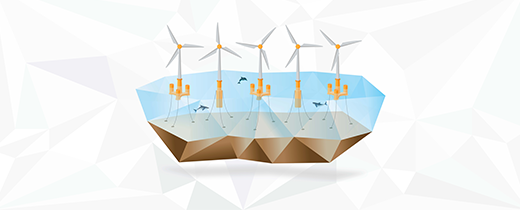
The project has developed an automatised mooring design optimisation tool. It couples OrcaFlex and ISIGHT software, allowing testing for a large variety of mooring designs. The tools find the most cost-effective design to address e.g. floater motions and accelerations, lines and anchor tensions. It’s been successfully applied for the Windcrete and ActiveFloat floaters in the West of Barra, Gran Canaria and Morro Bay sites.
The Corewind team is also working on recommendations to optimise O&M strategies and installation techniques for futre commercial floating wind farms. Its preliminary findings include:
- Establishment of a “good neighbourhood” communication is essential for reducing conflicts during the operation phase with other stakeholders (e.g. fishing industry);
- The walk-to-work system is the most promising technique to overcome the relative motions between floater and vessel and to accomplish a safe access.
For more information contact: Sabina or visit the Corewind website.
About Corewind: The COREWIND project provides disruptive and cost-effective solutions for floating offshore wind technology leading to cost reduction. It is developing innovative research, modelling and optimization for concrete-based floating substructure concepts.
Wind Harmony
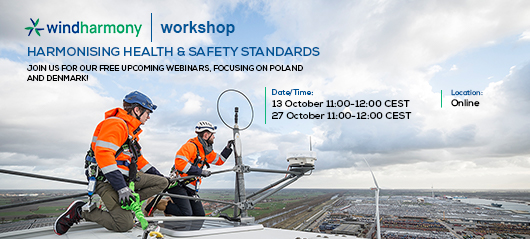
Wind Harmony is producing roadmaps for the industry and other stakeholders on proposed changes towards a European harmonisation on Health and Safety with recommendations for 7 areas:
- Training;
- Electrical, mechanical and other hazardous areas;
- Wind turbine safety design standards;
- Fitness to work and medical examinations;
- Emergency planning and response;
- Critical safety information sharing;
- Common approach to regulation and enforcement
Harmonisation would not only reduce complexity, risks and costs, but also allow for a truly global wind industry.
The project has two online best practice events coming up on. The first event, which will focus on Poland will take place on 13 October. The second will take place on 27 October and will focus on Denmark. The objective of these interactive webinars is to share best practices in health, safety and potential areas for harmonisation.
To register to the free online events, please visit this web page.
For more information contact Sabina Potestio.
About WindHarmony: The Wind Harmony project looks at health and safety (H&S) regulations and related standards impacting onshore and offshore wind energy across in Europe. It assesses and prioritises their potential for harmonisation or other type of intervention at European level.
ETIPWind
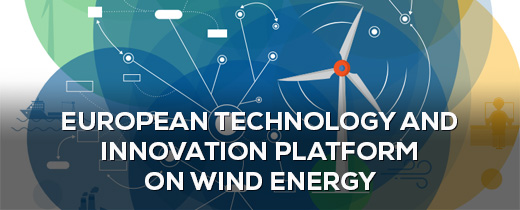
ETIPWind latest “Floating Offshore WInd: delivering climate neutrality” gives a graphic overview of the state-of-the-art floating offshore wind technology and the measures needed for commercialisation. It spells out the sector’s R&I recommendations allowing Europe to take the lead in a vast and untapped global market, as well as supporting European competitiveness. See it here.
The ETIPWind workshop on “Research & Innovation to deliver 450 GW of offshore wind” is now available online. The workshop was in collaboration with the EERA JP Wind and SETWind Annual Event 2020. Industry experts and researchers discussed the technology pathways to deliver 450 GW of offshore wind in Europe. Together with the participants they identified how to scale-up offshore technology and how to successfully install and manage these large volumes of offshore wind. See the video here.
For more information, contact Alexander Vandenberghe.
Upcoming EU funding opportunities and Research & Innovation policy
EU Recovery Plan
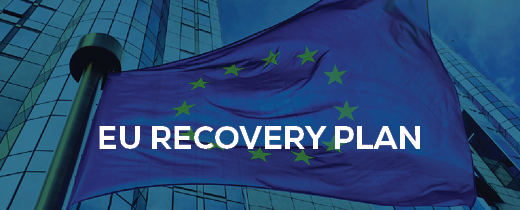
In July, Member States reached an agreement on an exceptional Recovery Strategy to counter the economic impacts of COVID-19. The total recovery package amounts to €1.82 trillion. It combines a €1.074 trillion proposal for the EU’s seven-year budget for 2021 to 2027 and an unprecedented recovery fund – Next Generation EU – worth €750 bn. The biggest single component of Next Generation EU will be the Recovery & Resilience Facility, worth €672.5 bn.
The Strategy recognises that “the renewable energy sector will be hit hard”. It singles out renewables as a priority, and commits to “rolling out renewable energy projects, especially wind, solar and clean hydrogen”. If properly implemented, the Recovery Strategy could be accelerate the European Green Deal. The budget will be allocated through both grants and loans.
The consultancy EY has identified 1,000 green projects which will support the EU’s Recovery Plan. The summary report highlights required investments to be €200 billion. Onshore and offshore wind projects are also featured on the list. The list of projects illustrates the huge project pipeline that exists across all European countries which could ensure a green and resilient recovery from the COVID-19 economic crisis. EY says the entire EU pipeline of green projects could be as high as €1 trillion.
For rolling updates on the instruments and budget, please visit our WindEurope website.
If you have a project that wants to benefit from funding, contact Sabina Potestio.
The European Green Deal
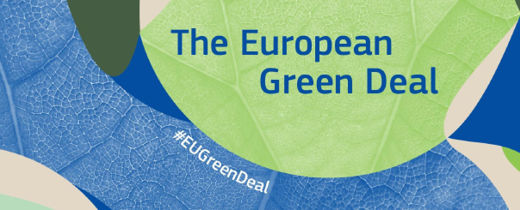
The European Commission has opened a call for R&I projects, with a €1 billion budget under Horizon 2020, to help the EU deliver on the Green Deal. The call has an exclusive focus on projects that have clear impacts in the short to medium-term (more focus on innovation than research).
The call dedicates €68 million to support offshore renewables and system integration. Offshore energy includes wind (bottom-fixed and floating), ocean energy and floating PV. Offshore projects must cover innovation in power generation technologies and may include new solutions to grid infrastructure and power transmission.
In addition, there are:
- €18 million for renewable heat solutions (could be for electrifying district heating);
- €60 million to demonstrate a 100 MW hydrogen electrolyser;
- €40 million to support deployment of renewables in Africa; and
- €80 million to decarbonise industrial processes (possibilities for direct electrification).
Projects can apply for up to €35 million in support, we will see at least two projects funded.
The call will support:
- Pilot applications, demonstration projects and innovative products;
- Innovation for better governance of the green and digital transition;
- Social and value chain innovation.
The deadline to apply for projects will be 26 January. Projects would start in Autumn 2021. On 22 October, we will be discussing the priorities and rules for applicants in a WindEurope Sofa Talk together with the European Commission.
For more information, contact Sabina Potestio.
Innovation Fund
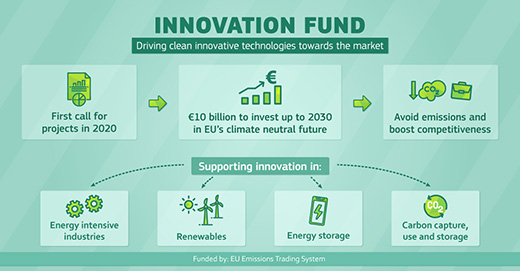
The Innovation Fund’s first call for proposals has been published. The Innovation Fund is one of the largest EU funding programmes for the demonstrating the contribution of innovative low-carbon technologies to greenhouse gas (GHG) reduction.
The Innovation and Networks Executive Agency (INEA) is responsible for implementing the calls, and provides extensive information and instructions for applicants on their website.
The call for proposals targets innovative renewables and energy storage technologies, and projects are selected according to these criteria:
- Effectiveness of greenhouse gas emissions avoidance;
- Degree of innovation;
- Project maturity;
- Scalability;
- Cost efficiency.
WindEurope strongly encourages its members to apply for funding of innovative projects in the area of wind energy. This includes projects that link wind energy to electrification or the production of renewable hydrogen. Floating wind projects, or hybrid projects, combining wind energy production with storage solutions or solar power production could also fall under the funding criteria.
The maximum co-financing rate is 60%. For large-scale projects, the application process is in two phases: expression of interest and full application. For small-scale projects, the application process will consist of just one stage. The first call is dedicated to large-scale projects.
More info here.
Electric City 2021 Innovation Park

Are you part of a European or national research project and you want to promote it? Would you like to attract new partners and disseminate your results? Look no further – we have the perfect solution for you. WindEurope’s Innovation Park is a pavilion designed to promote projects’ research and findings, and will feature at Electric City 2021 in Copenhagen (27-29 April). The goal of the pavilion is to provide high-profile visibility on the exhibition floor to projects, giving partners access to greater publicity and networking opportunities.
Benefits include:
- Your own exhibition space;
- A speaking slot on the Innovation Park stage;
- A printed logo on your exhibition space;
- Entry in the exhibitor list;
- Social media coverage;
- 2 Exhibitor staff passes (lunch included).
For more information, contact Tanguy Grandjean.
MaRINET2

The fifth and final MaRINET2 call has opened for free offshore renewables testing. The call is open to offshore energy technology developers who are looking to test their device or components. The winning projects will have access to a world-leading network of testing and testing infrastructure in Europe.
The application deadline is 16 October, and a webinar recording helping candidates with their application and in updating others on the process is available on the project website.
European Maritime and Fisheries Fund (EMFF)
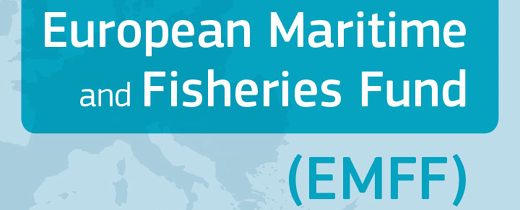
The European Maritime and Fisheries Fund (EMFF) has launched a call to boost Maritime Spatial Planning (MSP). The call aims to support Member States in setting up maritime spatial plans, and to ensure the plans are coherent and coordinated across relevant marine regions.
The Maritime Spatial Planning call is divided into two distinct topics:
EMFF-MSP-01-2020: Reserved for applicants from at least two coastal Member States bordering the targeted sea basins/marine regions, i.e. the North Sea and/or the Baltic Sea.
EMFF-MSP-02-2020: Reserved for applicants from at least one coastal Member State responsible for MSP in the concerned EU Outermost region(s).
The application deadline is 10 November.
For more information contact Sabina Potestio.
European Research & Innovation Days
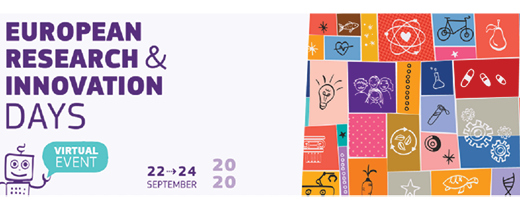
The European Commission’s annual flagship event focusing on Research & Innovation (R&I) brought together policymakers, researchers, entrepreneurs and the public for 3 days of intense policy co-designing, panels and matchmaking opportunities.
The fully virtual event included interactive sessions and gave participants the opportunity to provide input on how R&I policy and funding can help pave the way for a green, digital and resilient future.
The event featured a policy conference with several plenary sessions, covering a wide range of topics on R&I. These include:
- Shaping future R&I policy;
- Fair and just transition in the Green Deal;
- Digitalisation;
- EU funding;
- Synergies between EU and other funding programmes;
- International cooperation.
More information available here.
WindEurope Research & Innovation Quarterly Newsletter – Q2 2020
|
Watch online: webinar on how floating offshore wind can help Europe go climate-neutral
Floating offshore wind has a huge potential which remains largely unexploited. Massive amounts of wind resources exist in deep waters (+60m) where an estimated potential capacity of 4000 GW could be installed. This would open the door to offshore wind installations for countries such as Norway, Spain or Portugal.
One of the main drawbacks hindering floating offshore wind expansion is cost. This technology is still relatively expensive with a LCOE well above bottom fix technology. Innovative responses to key challenges on mooring and anchoring technology, power cables interconnection and O&M strategies are essential to pave the way for cost-competitive floating offshore wind.
This workshop-style webinar explored some of the solutions to these challenges together with experts, practitioners and captains of industry with insights from the COREWIND project (COst REduction and Increase Performance of floating WIND technology).
Download the webinar presentation slides:
Watch the full webinar here:
WindEurope Research & Innovation Quarterly Newsletter – Q1 2020
|
WindEurope Research & Innovation Quarterly Newsletter – Q4 2019
|
WindEurope Research & Innovation Your gateway to WindEurope’s EU-funded projects, October 2019 |
||
|
News from WindEurope projects
Launched in September 2019 COREWIND (COst REduction and increase performance of floating WIND technology) is a Horizon2020 project which aims to achieve cost reduction of offshore floating wind technology (15% LCOE reduction) by optimizing two components: mooring systems (including anchors) and power dynamic cables. The kick-off meeting, which took place at the European Energy Research Alliance (EERA) offices on the 2-3 of September, gathered all the partners and the European Commission. The partners outlined the work they will be carrying out. The Catalonia Institute for Energy Research (IREC) will be leading the consortium composed of industry and academia. These include the Technical University of Denmark (DTU), RAMBOLL, INNOSEA, Polytechnic University of Catalonia (UPC), Equinor, JDR cable systems, Polytechnic of Milan (POLIMI), University of Stuttgart (USTUTT), UL International GMBH, WindEurope, Cobra and Environmental Hydraulics Institute of Cantabria (IHCantabria). The project will last 42 months and it will contribute to the achievement of EU goals on strengthening of EU leadership in renewables by reducing costs. This is achieved by developing the next generation of floating offshore wind, making it a key player in the power generation sector.
The ETIPWind fact-sheet on blade recycling: “How Wind Is Going Circular” is now available. This short publication provides a graphic overview of the main technologies for recycling composite materials and spells out the sector’s research and innovation recommendation for material development and recycling. See it here. ETIPWind and SETWind will organise a joint conference session at WindEurope Offshore 2019. The session “Research and innovation: the outlook for offshore wind” will take place on Wednesday 27 November and will cover the next big innovations and technology developments in the wind energy sector. See more.
Launched in May 2019 the Wind Harmony study examines the potential alignment of health and safety standards – covering both onshore and offshore wind sites – from construction, operation, and maintenance, to decommissioning. You are invited to the first Wind Harmony workshop on 22 October. The workshop will assess the opportunities and challenges to facilitating the harmonization and alignment of safe, cost – effective and responsible health and safety across the wind industry. You can find further information in the detailed agenda. The following workshop will take place in Copenhagen on 28 November at the WindEurope Offshore Conference 2019. Please register here for the workshop on 22 October. For more information, contact Dorina Iuga at [email protected]
Launched in December 2017 SIMULWIND aims to develop a Wind Turbine Generator maintenance simulator. It will be used in the training of operation and maintenance workers. The project will end this December. You are invited to the final project event, which will take place in Copenhagen on 28 November at the WindEurope Offshore Conference 2019. You will see the final virtual reality-training tool and take part in a debate on the virtual/online training tools in training Operation and Maintenance professionals for the wind industry. For more information, contact Dorina Iuga at [email protected] Upcoming EU funding opportunities and Research & Innovation policy |
| Legal notice: The views represented in this newsletter are those of its authors and do not represent the views or official position of the European Commission. |  |
